During the mid to late 1860’s, various military powers in Europe were in process of changing their outdated percussion cap rifles to the newly developed self-contained metallic breech loading cartridge. Much of the work and research was done by the Mauser brothers, refining and improving on the bolt action development by German designer Nicholas von Dreyse that lead to the adoption in 1871 of the Mauser M71 rifle. This was a period in which firearm development and reseach moved along at a blistering pace in Europe and in June 1878 a commission was formed by the Portuguese War Minister Fontes Pereiro de Melo to select a suitable weapon for equipping the Portuguese Army to be selected from a variety of weapons aquired from various European powers.
Records dating from July and August 1880 mentioned rifle tests using an under-lever falling block, single shot rifle designed by Luiz Fausto de Castro Guedes Dias who was at that stage a 2nd Lieutenant in the 10th “Caçadores” Regiment. Feedback seemed favourable and created enough interest on the side of the War Ministry that the go-ahead was given enabling Guedes to continue testing his designs for the next two years and in December 1882 the Secretary of the War Ministry arranged for Guedes to be transferred to the Tancos Practical Academy of Engineering and in January 1883 gave instructions for a committee to evaluate the ongoing tests. In hindsight it seems strange that, while other European Military Powers were already adopting more modern bolt action rifles with multi-shot capacity, attention was still given to reseach of a single shot rifle. The testing done by Guedes centered around the firing and breech mechanisms of the rifle and not so much on a specific cartridge design because from correspondence to the War Ministry, Guedes requested from them “two Grass barrels and at least 1,000 complete Gras cartridges” as well as requests for reimbursements, leading to speculation that at least parts of these tests were financed by Guedes in his personal capacity and not by the Royal Arms Factory. It was also in the beginning of 1883 that Guedes indicated his intention to register patents on his designs for the breech and safety system of his designs which was granted to him on the 29th of July 1884

It was during June of 1883 that the Director General of the Artillery requesting larger scaled testing of the Guedes system at the Vendas Novas firing range. These tests carried on until June 1884 and received favourable recommendations by the evaluating committee and after this, the fine-tuning was transferred to the Royal Arms Factory workshop in Lisbon where orders were given for fifty rifles to be made according to the specifications supplied by Guedes. The first model Guedes system used a 4 grooved 11mm French Gras barrel and was a single shot breech loading rifle with a vertical sliding block underneath the action, very similiar to the Martini Henry rifle.
In July 1884 Guedes was sent by the War Ministry to Steyr in Austria to study the possibility of having the rifles manufactured in Austria and he was authorised to obtain twenty rifles manufactured at Steyr, nineteen in 11mm Gras caliber and one in 8mm but it was noted that these rifles came with slight improvements from the original ones manufactured at the Portuguese Royal Arms Factory. These rifles were tested by Guedes at the Vendas Novas range on the 14th of February 1885 in the presence of the evaluating committee and their report was sent to the Director General of the Artillery in April citing firstly the superiority of the 8mm cartridge compared to the 11mm and secondly the rifle suitable for adoption by the Military as the Model 1885 Guedes Rifle. The committee made a later recommendation that the charge of the 8mm round be increased from 4 gram (±62grains) to 4,5 grams (±70 grains) with the neccessary alteration to the chamber and barrel length/rifling.
In October 1885, a War Ministry dispatch was sent ordering the Director general of the Artillery to contract with the Ostterreichische Waffenfabrik-Gesellschaft (OEWG) at Steyr for 9,000 Kropatcheck Carbines, of which 6,000 was for the Caçadores Regiment and 3,000 for the Cavalry, together with the machinery to manufacture the ammunition while in July 1886 a new order for 40,000 8mm Guedes System Rifles. It would seem strange however that Portugal would order a superior bolt action rifle at the same time as an “outdated” single shot rifle. The 8mm Guedes was actually the first small caliber infantry cartridge accepted (although not adopted) by any European nation and preceded the 8mm French Lebel by a few months (Bester p.160), although the Lebel was the first to use the newly developed smokeless propellant, or “Poudre B” developed by French chemist Paul Vieille. Small alterations to the breech-block were done at Steyr as a result of extraction problems experienced from the higher loading. However, in a dispatch dated 21st of March 1886 it was noted that during testing of the first rifles problems were experienced with a ‘systematic downward dislocation of the breech-block’ and it was noted also where a knock on the rifle butt would cause the breech-block to open, a direct result of the previous alterations to the higher loading, causing pressure stress on the breech. This meant that each rifle had to be individually checked and corrected, but the OEWG stated in their correspondence that it would not accept responsibility for the stability and safety of the rifle during firing. Having been notified of this, a telegram was sent from the War Ministry to the OEWG on the 26th of March 1886, notifying them of suspending the manufacture of the System Guedes rifles.
On the 9th of April 1886 a dispatch was issued by the War Ministry stating that notwithstanding the superiority of the rifle, it would be rejected by the military as long as it was still using the System Guedes breech, after finally realising that adopting a single shot rifle when the rest of the world was adopting bolt action rifles was a step in the wrong direction and noting this fact to the OEWG, Portugal requested a reduction of the order placed of what they assumed around 18,000 rifles already manufactured. Citing their contractual obligations, the Steyr factory refused and accepted the offer to complete the order, but substituting the Guedes with Kropachek rifles, while keeping all Guedes rifles they had already manufactured and in stock. A telegram sent by the War Ministry on the 8th of May officially rejected the Guedes rifle and permitting substitution with the Kropachek, thus standardising/modernising the armament of the Portuguese Army.
THE GUEDES RIFLE IN SOUTH AFRICA
There is a comprehensive discussion in Bester et al; Small Arms of the Anglo-Boer War 1899 – 1902, (2003: Kraal Publishers; ISBN 1-874979-31-6) and as mentioned elsewhere and before, although this site is dedicated to the study and research of the cartridges used in guns described above, it would be helpful to do a short synopsis of the Guedes rifle in South Africa.
Bester, et al.:165 noted that it was unclear when the first Guedes rifles landed in South Africa, but it must have been prior to 1893 from existing correspondence and that the Guedes was already in use by the Boer forces at the time of the Jameson Raid (29 December 1895 – 2 January 1896), a failed attack by British colonial administrator Leander Starr Jameson and his Company troops (“police” in the employ of Alfred Beit’s and Cecil Rhodes’ British South Africa Company) and Bechuanaland (modern day Botswana) policemen over the New Year weekend of 1895–96 against the ZAR or Zuid Afrikaanse Republiek (South African Republic), that was known as the Transvaal. The intention was to trigger an uprising by the primarily British expat workers (known as Uitlanders), but the raid was a failure. The workers were called the Johannesburg conspirators and they were expected to recruit an army and prepare for an insurrection. The result was an acute embarrassment for the British government; the replacement of Cecil Rhodes as premier of the Cape Colony; and the strengthening of Boer dominance of the Transvaal and its gold mines. The raid was a contributory cause of the Anglo-Boer War (1899–1902).
The first official military order of Guedes rifles was on the 16th of August 1893 when 160 rifles and 80,000 rounds of ammunition were ordered form the company Stein & Hunter, who were the South African agents for the Birmingham firm of Alfred Field & Co. It is stated in Bester, et al.:166 that Stein & Hunter had about 8,000 Guedes rifles available and were looking to sell the whole lot to the ZAR. It must also be noted that the Commandant-General of the ZAR approached the Z.A.F.O.S. (De Zuid Afrikaansche Fabrieken voor Ontplofbare Stoffen Beperkt) or the South African Explosives Factory Limited to manufacture ammunition for the Guedes and looking at the records of the number of rounds imported – (12 660 300 from official Z.A.R. orders as well as an additional 5 000 000 from a private Z.A.F.O.S. order) – it would seem highly unlikely that the Guedes cartridge was ever manufactured in South Africa.
There has long been speculation that, even though the Steyr factory reported that there were 18,000 of the original order of 40,000 Guedes rifles manufactured, it was far more likely that only around 8,100 were ever made. This is illustrated in the correspondence between the ZAR and Stein & Hunter that even after the abortive Jameson Raid and in the period before the outbreak of the Anglo Boer War in 1899 the ZAR could never manage to obtain more than 7,500 Guedes rifles.
SOURCES: REGALADO, J. – BULLETIN OF THE PORTUGUESE ACADEMY OF ANTIQUE ARMS.
BESTER, R. ET AL – SMALL ARMS OF THE ANGLO BOER WAR 1899 – 1902. (2003: Kraal Publishers; ISBN 1-874979-31-6)
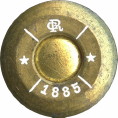

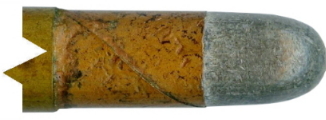 First loading (1885) with Foil Patched Lead bullet
First loading (1885) with Foil Patched Lead bullet
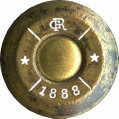
 Later Roth production with steel patch bullet
Later Roth production with steel patch bullet
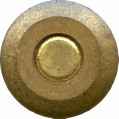

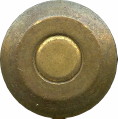

First specimen has a segmented mouth crimp, see also below.
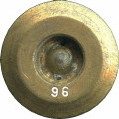

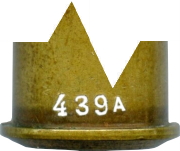 Early DWM case with case number stamped on the base.
Early DWM case with case number stamped on the base.
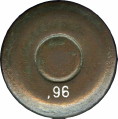

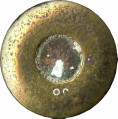

First specimen has a bullet diameter of 7.85mm. This might be the old DWM case #439 (not 439A). Info still to be verified. Second specimen with lead bullet, so this would have been a blackpowder load. Paper patch missing
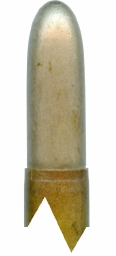
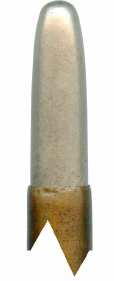
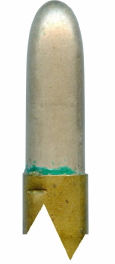


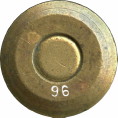

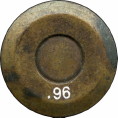

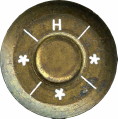

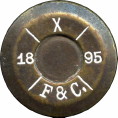

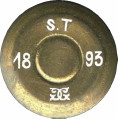

F&C – Fabrica Nacional de Muniçoes (Chelas)
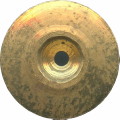
 From RSACCA 216 (1st Quarter 2006) – this case was manufactured during the mid-60’s by a local manufacturer, Mr. Olekowsky for a local client who had a rifle from the Anglo Boer War.
From RSACCA 216 (1st Quarter 2006) – this case was manufactured during the mid-60’s by a local manufacturer, Mr. Olekowsky for a local client who had a rifle from the Anglo Boer War.
